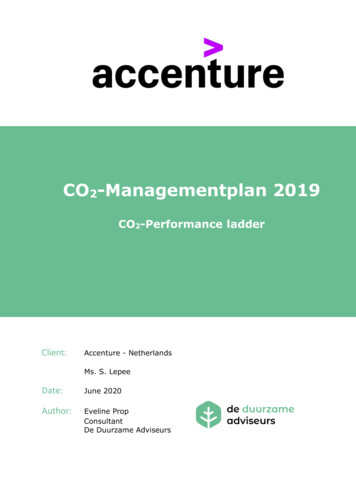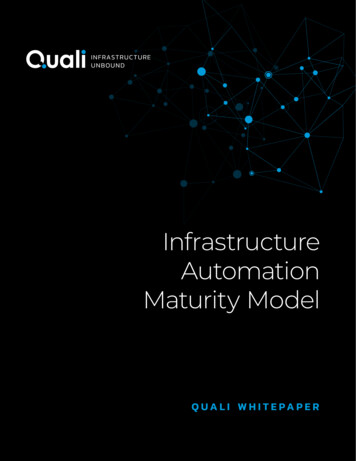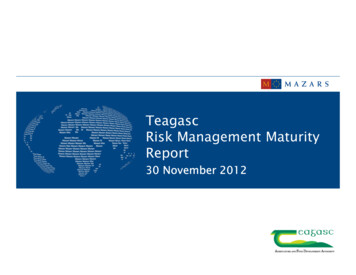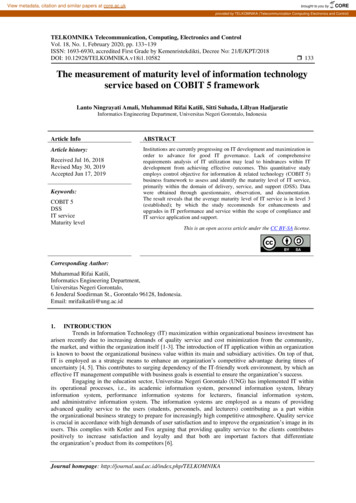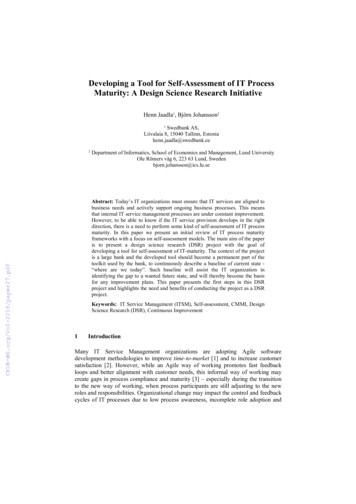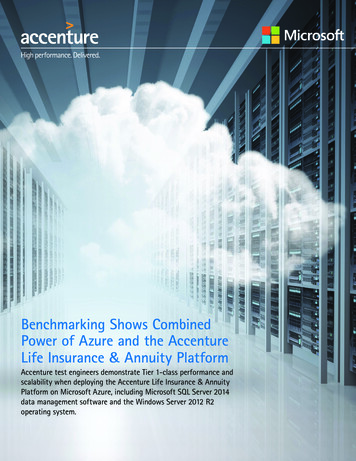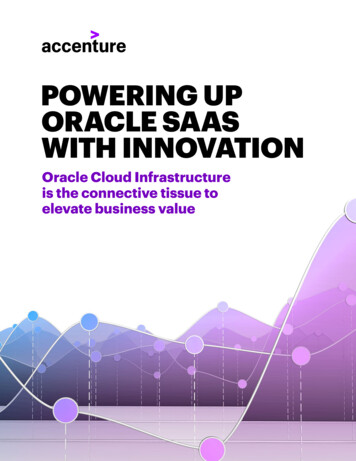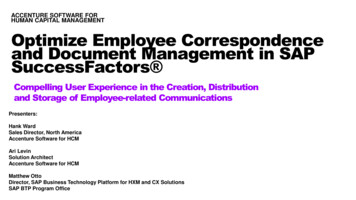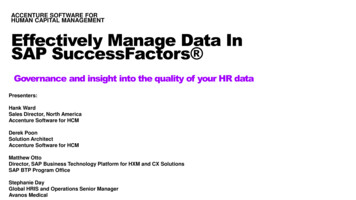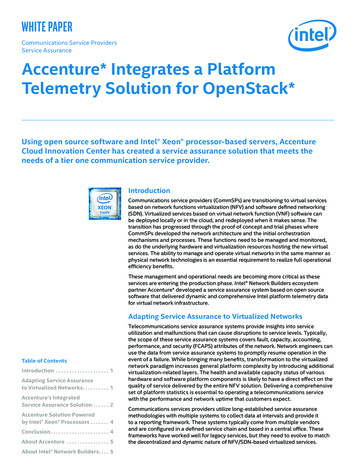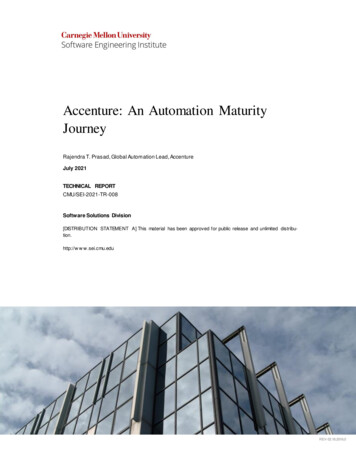
Transcription
Accenture: An Automation MaturityJourneyRajendra T. Prasad, Global Automation Lead, AccentureJuly 2021TECHNICAL REPORTCMU/SEI-2021-TR-008Software Solutions Division[DISTRIBUTION STATEMENT A] This material has been approved for public release and unlimited distribution.http://w w w.sei.cmu.eduREV-03.18.2016.0
Copyright 2021 Carnegie Mellon University.This material is based upon w ork funded and supported by the Department of Defense under Contract No.FA8702-15-D-0002 w ith Carnegie Mellon University for the operation of the Softw are Engineering Institute, afederally funded research and development center.The view , opinions, and/or findings contained in this material are those of the author(s) and should not be construed as an official Government position, policy, or decision, unless designated by other documentation.References herein to any specific commercial product, process, or service by trade name, trade mark, manufacturer, or otherw ise, does not necessarily constitute or imply its endorsement, recommendation, or favoringby Carnegie Mellon University or its Softw are Engineering Institute.This report w as prepared for the SEI Administrative Agent AFLCMC/AZS 5 Eglin Street Hanscom AFB, MA01731-2100NO WARRANTY. THIS CARNEGIE MELLON UNIVERSITY AND SOFTWARE ENGINEERING INSTITUTEMATERIAL IS FURNISHED ON AN "AS-IS" BASIS. CARNEGIE MELLON UNIVERSITY MAKES NOWARRANTIES OF ANY KIND, EITHER EXPRESSED OR IMPLIED, AS TO ANY MATTER INCLUDING, BUTNOT LIMITED TO, WARRANTY OF FITNESS FOR PURPOSE OR MERCHA NTABILITY, EXCLUSIV ITY, ORRESULTS OBTAINED FROM USE OF THE MATERIAL. CARNEGIE MELLON UNIVERSITY DOES NOTMAKE ANY WARRANTY OF ANY KIND WITH RESPECT TO FREEDOM FROM PATENT, TRADEMA RK,OR COPYRIGHT INFRINGEMENT.[DISTRIBUTION STATEMENT A] This material has been approved for public release and unlimited distribution. Please see Copyright notice for non-US Government use and distribution.Internal use:* Permission to reproduce this material and to prepare derivative w orks from this material for internal use is granted, provided the copyright and “No Warranty” statements are included w ith all reproductionsand derivative w orks.External use:* This material may be reproduced in its entirety, w ithout modification, and freely distributed inw ritten or electronic form w ithout requesting formal permission. Permission is required for any other externaland/or commercial use. Requests for permission should be direc ted to the Softw are Engineering Institute atpermission@sei.cmu.edu.* These restrictions do not apply to U.S. government entities.Carnegie Mellon is registered in the U.S. Patent and Trademark Office by Carnegie Mellon University.DM21-0681CMU/SEI-2021-TR-008 SOFTWARE ENGINEERING INSTITUTE CARNEGIE MELLON UNIVERSITY[DISTRIBUTION STATEMENT A] Approved for public release and unlimited distribution.
Table of ContentsAbout AccentureivExecutive SummaryvAbstractvii1Origins of Our Automation Journey12Objectives and Goals of Our Automation Journe y23Our Solution: The “4S Model”3.1 The “4S Model”3.1.1 Simple3.1.2 Seamless3.1.3 Scalable3.1.4 Sustainable4445554Implementing the 4S Model4.1 Automation Integrated Across the Software Engineering Lifecycle4.2 Integrated Automation Platform and Delivery Assets4.3 Contextualized Implementation Model4.4 Agile Automation Practices4.5 Measure What eliveryValue Creation, Schedule Adherence, and SLA ComplianceEffect of Automation on Quality and CostEffect of Automation on Culture ChangeAnalyst Recognition6How6.16.26.36.46.56.6We Continuously Evolve the Automation JourneyAutomation Innovation CouncilAutomation Storytelling WorkshopAutomation UniversityAutomation Career ModelAccenture Innovation HubsAcademic 08 SOFTWARE ENGINEERING INSTITUTE CARNEGIE MELLON UNIVERSITY[DISTRIBUTION STATEMENT A] Approved for public release and unlimited distribution.151515151616161718i
List of FiguresFigure 1:Percentage of Projects Delivering on Time11Figure 2:Service-Level Agreement Performance11Figure 3:Application Availability12Figure 4:Cost of Rework12Figure 5:Automation and Cost Savings13Figure 6:Automation Adoption13Figure 7:Growth in Asset Harvesting14CMU/SEI-2021-TR-008 SOFTWARE ENGINEERING INSTITUTE CARNEGIE MELLON UNIVERSITY[DISTRIBUTION STATEMENT A] Approved for public release and unlimited distribution.ii
List of TablesTable 1:The 4S ModelTable 2:Service-Level Performance by Business GroupCMU/SEI-2021-TR-008 SOFTWARE ENGINEERING INSTITUTE CARNEGIE MELLON UNIVERSITY[DISTRIBUTION STATEMENT A] Approved for public release and unlimited distribution.411iii
About AccentureAccenture is a global professional services company with leading capabilities in digital, cloud,and security. Combining unmatched experience and specialized skills across more than 40 industries, we offer Strategy and Consulting, Interactive, Technology, and Operations services—allpowered by the world’s largest network of Advanced Technology and Intelligent Operations centers. Our 537,000 people deliver on the promise of technology and human ingenuity every day,serving clients in more than 120 countries. We embrace the power of change to create 360-degreevalue and shared success for our clients, people, shareholders, partners, and communities. Visit usat www.accenture.com.We are one global team: 537,000 Accenture employees worldwide 6,000 clients served throughout more than 120 countries 7,900 patents and patents pending worldwide 200 cities with Accenture locations and operations, across 50 countries 185 partners in our ecosystem 100-plus innovation centers 40-plus industries represented by expertsAccenture Technology is the global leader in the most vital technologies today—technologies thatare underpinning the world’s accelerated digital transformation and that are critical to growingand rebuilding our global economy, including artificial intelligence (AI), intelligent automation,cloud, security, data, and analytics. Accenture is at the heart of thousands of businesses, drivingimmediate response and longer-term transformation that will define the future. This is evidencedby our leadership in software engineering, application management, infrastructure, the most pervasive intelligent platforms (such as SAP, Oracle, and others), a massive research and innovationengine of labs and investments, the largest innovation delivery operation in the world, and our unparalleled expertise in more than 40 industries, from healthcare to finance to consumer goods.CMU/SEI-2021-TR-008 SOFTWARE ENGINEERING INSTITUTE CARNEGIE MELLON UNIVERSITY[DISTRIBUTION STATEMENT A] Approved for public release and unlimited distribution.iv
Executive SummaryAccenture began a journey more than six years ago to transform its software development and application delivery lifecycle through intelligent automation and intelligent technology assets. Inthat time, we have globalized and industrialized an end-to-end automation framework, practices,and technology platform called Accenture myWizard across Accenture to address one of thebiggest automation challenges: implementing a future-ready, mature level of automation throughout the software engineering lifecycle at speed and scale.Early 2015 marked the beginning of a profound change when more and more of our clients startedembarking on their digital transformation journey. From cloud adoption and data-driven strategiesto new ways of working and emerging technologies, keeping up with fast-changing technology isvital to Accenture’s business and the business dynamics of our clients. We recognized that automation and reimagining the way we deliver information technology (IT) and build IT systemswould need to play a significant role in these evolutions.The possibilities that automation presented for companies were expanding. The expectations fromclients were shifting the paradigm to (1) view automation as a key enabler to differentiate the customer experience through seamless human plus machine interactions and (2) use automation toincrease innovations and get a competitive edge in the market.To become the best partner to our clients in their digital transformation journey through automation, we needed to fundamentally change how IT organizations built, implemented, and operatedsystems. But this required a change in the way automation was being implemented in the earlydays. There were several underlying organizational challenges facing organizations that preventedthem from realizing the full potential of automation to drive business transformation or reinventthe way we work: Automation was being implemented in a siloed manner as point solutions in functional andvertical areas. Automation was viewed as more of an individual efficiency improvement mechanism thanan enabler for enterprise-wide transformation. Automation was not defined as a technology skill or supported by a dedicated workforce.To embrace changing technology at speed and make automation an advantage, organizations’practices had to be stable and scalable to constantly adapt to the agility of the market, the business, and ever-changing customer expectations. Hence, the automation journey itself needed astructure to lay a strong foundation and enable continuous evolution. We determined that processmaturity leveraging the Capability Maturity Model Integration (CMMI) High Maturity (HM)model would be a strong foundation for driving automation as a transformation lever. Leveragingthe CMMI HM model, we mapped an automation journey structure built on the following stages: Identify what to automate using our Automation Opportunity Finding Framework. Industrialize automation through automation platforms. Measure value from automation.CMU/SEI-2021-TR-008 SOFTWARE ENGINEERING INSTITUTE CARNEGIE MELLON UNIVERSITY[DISTRIBUTION STATEMENT A] Approved for public release and unlimited distribution.v
Continuously automate.This structured automation approach worked very well in driving automation at scale across Accenture and our clients. There were clear benefits and outcomes that this brought to our clients,for example1 : 5-8X increase in speed to market of software releases 50-60% reduction in ticket incident volumes 40-60% reduction in IT costs for clients from productivity improvements Over 10,000 automation process improvement opportunities in the five years from 2016 to20201This data is derived from Accenture project implementations as examples of best-case results. This is proprietary data not publicly available.CMU/SEI-2021-TR-008 SOFTWARE ENGINEERING INSTITUTE CARNEGIE MELLON UNIVERSITY[DISTRIBUTION STATEMENT A] Approved for public release and unlimited distribution.vi
AbstractAccenture, an early adopter of the Capability Maturity Model Integration (CMMI) framework,faced numerous challenges related to a rapidly changing market. Its clients were looking to Accenture to help them “hyper-drive” system transformations to achieve greater cost effectiveness,faster speed, better quality, and continuous innovation to stay relevant in the market. To achievethese goals, Accenture launched an automation journey built around what it calls “The 4SModel”: Simple, Seamless, Scalable, Sustainable. The process produced intelligent tools to automation for transformation that enabled Accenture and its clients to transform rapidly and meet thechallenges of a changing market and business landscape. Process improvement initiatives are nowimplemented across more than 50% of Accenture’s industry client base, with new automation opportunities identified every three hours. Automation strategy, process, and technology programsestablished have shown an impact on client value delivered, delivery performance, and peopleperformance. Some of the key metrics that have shown a significant improvement consistently areproductivity, quality (defects), effort, and schedule. In 2020, the Carnegie Mellon University Software Engineering Institute and IEEE recognized Accenture with the Watts Humphrey SoftwareProcess Achievement Award. For more information on the SPA Award, visit atts/.CMU/SEI-2021-TR-008 SOFTWARE ENGINEERING INSTITUTE CARNEGIE MELLON UNIVERSITY[DISTRIBUTION STATEMENT A] Approved for public release and unlimited distribution.vii
1 Origins of Our Automation JourneyAccenture is one of the early adopters of the Capability Maturity Model Integration (CMMI)framework and has greatly benefited from adopting its best practices, processes, and standards.Doing so was one of the enablers for us to provide world-class services to our clients. Our delivery capabilities bring together industrialized assets with deeply skilled technology and industryprofessionals focused on generating measurable business value for our clients through reliable,cost-effective, and consistently high-quality solutions. Continuous improvement pivoted onCMMI practices helped us drive higher levels of productivity, precision, and predictability.However, our clients were facing never-before-seen levels of competitiveness, digital disruptions,cost pressures, shareholder expectations, and regulatory challenges. Since the market was changing very rapidly, clients were looking to Accenture to help them “hyper-drive” system transformations. It became imperative that we look beyond delivering quality products and meeting clientexpectations. There was a high demand for greater cost effectiveness, faster speed, better quality,and continuous innovation to stay relevant in the market.Automation stood out as a natural choice to become a game changer for us. Consequently, westarted stepping up our automation game—from intelligent tools to automation for transformation—to enable us and our clients to transform rapidly to meet the challenges of a changingmarket and business landscape.CMU/SEI-2021-TR-008 SOFTWARE ENGINEERING INSTITUTE CARNEGIE MELLON UNIVERSITY[DISTRIBUTION STATEMENT A] Approved for public release and unlimited distribution.1
2 Objectives and Goals of Our Automation JourneyBuilding on our CMMI foundation, Accenture began its automation journey to help strengthenour process maturity and realize the full value of automation efforts. We kept the following objectives in mind:1.Strengthen process maturity: Having a robust process—and adhering to it—is paramountto successful automation and the adoption of any new technologies. Automating an inefficient process multiplies the inefficiencies, which can lead to failed efforts without understanding the cause of the failure. The full potential of automation is only achieved if the processes are designed effectively. Very often, this requires a process assessment and processre-engineering to make it more efficient and resilient. Once the process becomes more mature, the implementation of automation solutions starts to become more rewarding and results in higher adoption.2.Integrate solutions: When starting an automation journey, point solutions are often implemented that are largely decoupled. Such a piecemeal approach hinders scaling and efficiency.3.Establish a holistic automation implementation structure: A fragmented approach to automation (identifying individual opportunities as they arise and implementing specific toolsto solve a specific problem) creates unnecessary complexity and can also hinder the ability toscale.4.Reduce duplication and increase re-use: Processes evolve over time, and a structuredframework is needed to access the utility of the automation solutions over time.5.Infuse new ways of working into technologies and processes : Many organizations continue to depend on the traditional waterfall model for design, development, testing, and deployment of IT applications. Doing so leads to long turnaround times for automation solutions. Mature intelligent automation embraces modern engineering practices, such as rapidprototyping and agile development and/or deployment, that include tolerance for failing fast.6.Strengthen organization automation culture: To increase the speed of adoption and theeffective use of automation on the ground by the practitioners, there is a need for clearlycommunicating changing roles and processes, embracing continuous innovation and continuous improvement, and championing excitement about the opportunities and value that automation can bring.Accenture’s goals were to develop, scale, and strengthen process improvements to enable implementation of automation at scale with high ease, speedy deployment and highquality drive faster time to market, higher quality, and predictability increase efficiency and reduce operational costs for clients through higher application stability, reduced technical debt, and high operational efficiency future-proof the software engineering framework and automation journey with a solution andapproach that transforms IT into a future system (boundaryless, adaptable, and radically human)CMU/SEI-2021-TR-008 SOFTWARE ENGINEERING INSTITUTE CARNEGIE MELLON UNIVERSITY[DISTRIBUTION STATEMENT A] Approved for public release and unlimited distribution.2
drive business return on investment (ROI) for clients with IT service delivery that is valuefocused and business alignedCMU/SEI-2021-TR-008 SOFTWARE ENGINEERING INSTITUTE CARNEGIE MELLON UNIVERSITY[DISTRIBUTION STATEMENT A] Approved for public release and unlimited distribution.3
3 Our Solution: The “4S Model”3.1The “4S Model”We designed an automation solution called the “4S Model” to scale and sustain intelligent automation at an enterprise-wide level. 4S stands for Simple, Seamless, Scalable, and Sustainable—based on four underlying key principles.Tab le 1:The 4S ModelSim pleSeam lessScalableSustainableMake automation simpleby identifying the right opportunities/use cases withthe biggest impact tobusinessMake automation seamless for use and adoption,so there is an ROI to thebusinessMake automation scalable across the enterpriseso there is full realizationof the automation valuefor the businessMake automation sustainable and continuouslyevolving to ensure continuous value generation3.1.1SimpleThe very first step is to get your business processes right by applying techniques like lean principles and Six Sigma to eliminate work and eradicate unnecessary processes. Do not automate inefficient processes because, once automated, inefficiency will just run more efficiently. And you donot want to get into that situation! Eradicate, optimize, and automate.Once you have eliminated wasteful, inefficient processes, you need to figure out where you are onyour automation journey. This is a very important step. Watts S. Humphrey, the “Father of Software Quality,” said, “If you don’t t know where you are, a map won't help.” Performing a baselining and benchmarking exercise lets you know where you are and how you are progressing. Accenture’s Automation Opportunity Finder is a structured framework to identify a company’scurrent Automation Maturity Index and opportunities to eliminate, optimize, and automate. This isbased upon industry-leading practices like the IT Infrastructure Library (ITIL), CMMI, ControlObjectives for Information and Related Technology (COBIT), lean methodology, VeriSM, andSix Sigma. Accenture’s Automation Opportunity Finding Assessment covers the people, process ,and technology aspects of the IT organization to discover and design a sustainable and evolvingfuture-proof automation ecosystem for our clients. The Automation Opportunity Finder suite enables delivery by finding automation opportunities and estimating the ROI for every automationuse case, prioritizing based on business value. It also establishes an approach for reporting, governance, and tracking benefits. It’s all very simple, yet very critical.One large company faced challenges in its commercial operations, particularly with a high volume of month-end unpaid invoices. Accenture used the Automation Opportunity Finder to perform process analysis and deployed automation solutions in the business development authorization and reporting processes. A standardized monthly billing calendar was aligned to thecompany’s accounts payable schedule with weekly reporting of receivables highlighting overduebills. With a consistent weekly cadence of automated chasing, escalation, and support to controlowners, there was significant improvement, including around a 50 percent reduction in month-endoverdue receivables, and the quality assurance compliance score became consistently green.CMU/SEI-2021-TR-008 SOFTWARE ENGINEERING INSTITUTE CARNEGIE MELLON UNIVERSITY[DISTRIBUTION STATEMENT A] Approved for public release and unlimited distribution.4
3.1.2SeamlessThe second important principle seeks to ensure that you can introduce new innovations to yourtechnology and tooling landscape without causing a wave of disruption. You need seamlessnessbetween the existing technology ecosystem and the automation layer. If you are using ServiceNow, for example, your automation enablement must be in line with your ServiceNow strategy. Ifyou are using Elasticsearch, Logstash, and Kibana (ELK) as an open source software for your analytics and artificial intelligence (AI), you need to have open source plug-and-play applicationprogramming interfaces (APIs) that you can connect to. You need to integrate your automationlayer using APIs, microservices, and containers, as opposed to pushing one more tool or asset intothe existing technology environment. A seamless, accurate data fabric is also critical.At Accenture, we built Accenture myWizard , an intelligent automation platform that uses open,microservices-based architecture, APIs, and a seamless data fabric that allows clients to plug innew innovations and tools all the time without disrupting the existing tooling landscape. Irrespective of the tools and technologies our clients use, myWizard offers API gateways and plug-ins ontop of a seamless data lake and AI core engine to enable seamless integration into the environment they are operating.3.1.3ScalableBut how do you scale? By building capability and expertise. Scaling AI and automation capabilities at an enterprise level requires a holistic strategy that cuts across all types of talent segmentsand skills. Within Accenture, we established an Automation University that offers automation certifications and training to our people—starting from Automation Prime, Automation Architect,and Automation Coach to Automation Champion. An Automation Prime, for instance, has deepexpertise in a set of tools such as Splunk or Kubernetes, while an Automation Architect has theskills to build automation across every aspect of software, from development and testing tomaintenance and infrastructure. An Architect can then graduate to become an Automation Coac hand help clients implement and deploy automation. Throughout this journey, the goal is to constantly build expertise not just in automation and AI but also in Agile and design thinking.3.1.4SustainableChange is the only constant, and this is true of automation, too. To keep pace with relentlesschange, you need a sustainable way to harvest new ideas and continuously invest in automation.Whether this is through hackathons, AI-thons, or any other continuous innovation initiatives, yourown people can provide the best ideas and can help you track industry trends. Secondly, user experience is often overlooked in automation initiatives. But bad user experiences can be a dealbreaker and hindrance to successful automation at scale. Invest in design thinking and human-centered design to ensure success. Finally, you need a way to monitor business value. Track everydollar of investment and saving. Value realization and measurement are essential to sustain automation. One way we to realize and measure value is to hold regular co-creation sessions with clients to continuously strengthen the automation implementation.We also do design-thinking exercises. For example, one way we work with companies to build ahuman-centric culture of automation in their business is we ask employees to identify each taskthey do. We then ask them to categorize each task and identify which tasks they find monotonousCMU/SEI-2021-TR-008 SOFTWARE ENGINEERING INSTITUTE CARNEGIE MELLON UNIVERSITY[DISTRIBUTION STATEMENT A] Approved for public release and unlimited distribution.5
or repetitive and which tasks they enjoy or value. We take the tasks they don’t like and automatethem. This helps make the case for prioritizing automating tasks that are not highly valued andcreates buy-in with talent about the automation process. This also helps create a culture of “automation-first” thinking where automation becomes an integral part of day-to-day operations.This, in a nutshell, is our approach to automation: eradicate, optimize, and then automate in a simple, seamless, scalable, and sustainable manner.CMU/SEI-2021-TR-008 SOFTWARE ENGINEERING INSTITUTE CARNEGIE MELLON UNIVERSITY[DISTRIBUTION STATEMENT A] Approved for public release and unlimited distribution.6
4 Implementing the 4S Model4.1Automation Integrated Across the Software Engineering LifecycleInfusing automation means incorporating automation and AI into the modern engineering and service lifecycle management methodology. This enhances quality, user experience, business satisfaction, self-service capabilities, security, compliance, and productivity.We have applied automation to the entire software delivery lifecycle, including the software application development and application and infrastructure management phases. Some examples ofhow automation is weaved into the application development lifecycle include the following: With automation, we have realized 25-30% efficiency improvement2 in program planningand management by having digitized, real-time, and bidirectional roadmaps; integrated analytics; and in-built workflows for tracking milestones, deliverables, and dependencies. We have achieved 20% more efficiency in requirements management and a 30% reduction inrequirements defects with a robust and intelligent requirements management that fosters continuous shift-left requirements quality control, change impact analysis, and AI-enforced corrections to avoid defects in product releases. We have achieved delivery agility by infusing automation in the release planning and execution phases. Automation includes (1) adding a virtual scrum master role to augment the roleof scrum master, (2) implementing CI/CD early during the project startup phase, and (3) using real-time predictive and descriptive analytics during the project execution stages and optimizing test suites.Automation has revolutionized application and infrastructure management, making IT predictive,self-servicing, and self-healing. Examples include the following: Automated solutions proactively identify and correct potential issues before they cause problems. Automation solutions have been implemented for monitoring, event correlation, ticket management activities, and service management activities. Deep-dive analytics continuously drive service improvements. Virtual Agents and automated alerts and recommendations continuously manage processchanges, helping improve efficiency while minimizing delivery risks.All help to deliver maximum, business-aligned outcomes and improve customer satisfaction.2This and follow ing data are derived from Accenture project implementations across software engineering andvarious industries. This is proprietary data not publicly available.CMU/SEI-2021-TR-008 SOFTWARE ENGINEERING INSTITUTE CARNEGIE MELLON UNIVERSITY[DISTRIBUTION STATEMENT A] Approved for public release and unlimited distribution.7
4.2Integrated Automation Platform and Delivery AssetsScalability and “future-proofing” automation was the need of the hour. We determined that implementing automation at a large scale and driving consistent results across the enterprise required aplatform-centric approach. So we conceived and built Accenture myWizard as an end-to-end delivery automation platform that drives the automation process and maturity in delivery. AccenturemyWizard brings the best of AI-driven automation and technology assets together across the software delivery lifecycle to help enterprises reimagine IT. An innovation platform that integrates allthe capabilities needed to manage the software delivery lifecycle, it drives delivery excellence, executes the IT function, and drives intelligent automation across the enterprise.4.3Contextualized Implementation ModelWhen implementing automation at scale, developers need to take into consideration that every automation solution poses unique and contextual implementation challenges. Our approach to implementing automation solutions depends on use cases, such as the complexity of implementation,the user base exposure of the solution, business criticality, and the level of human machine interaction [Daugherty 2018]. Although the base activities of the implementation model are thesame, the model must be tailored to the nature of automation use cases. We engage associatedsubject-matter experts (SMEs) right from the start. If the automation will impact a considerablenumber of users, we plan for training, learning opportunities, and detailed user guides. Businesscritical automations will have even tighter controls with thorough stage-gate reviews.4.4Agile Automation PracticesAutomation requires rapid prototyping and agile development and deployment, including tolerance for fail-fast and learn-fast modes of execution. An automation implementation model that isiterative, adaptive, and collaborative in nature is essential to effectively and efficiently implementand scale automation solutions. We have adopted an innovation-led Explore-Experiment-Expand(EEE) automation framework to improve adoption of automation that features fast feedback cycles that help
at www.accenture.com. We are one global team: 537,000 Accenture employees worldwide 6,000 clients served throughout more than 120 countries 7,900 patents and patents pending worldwide 200 cities with Accenture locations and operations, across 50 countries 185 partners in our ecosystem 100-plus innovation centers
